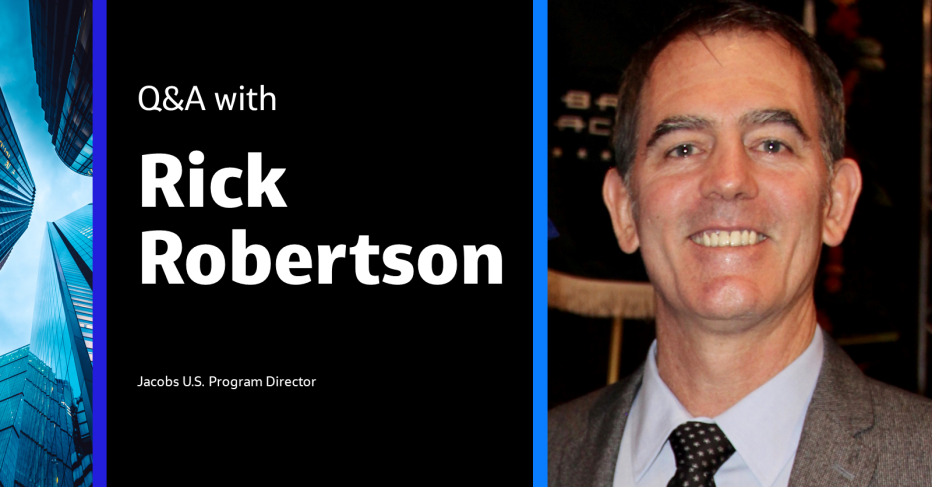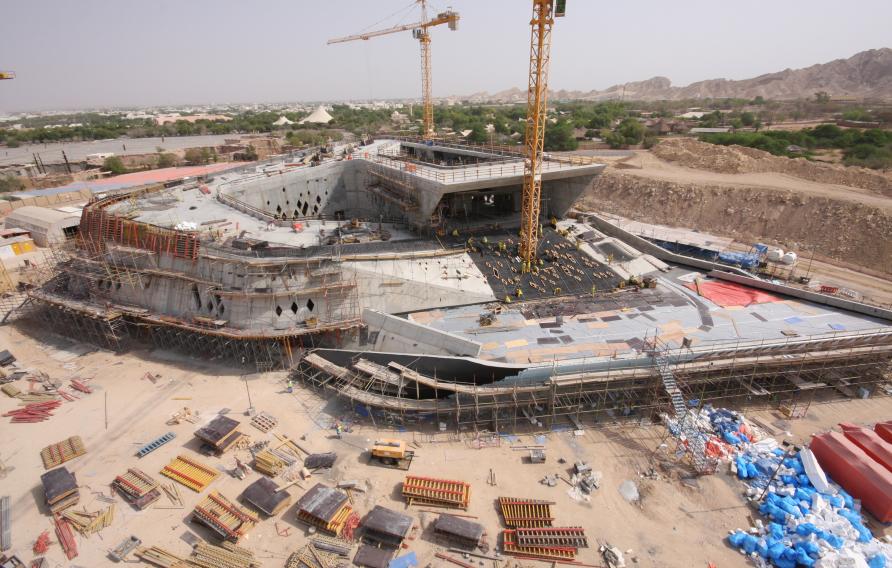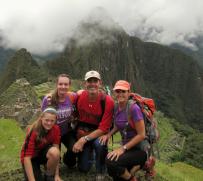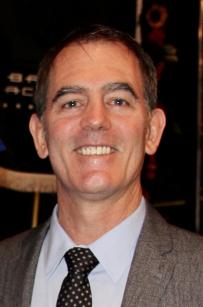Reinventing Tomorrow’s Major Programs Through Talent, Diversity and Technology: A Q&A With Rick Robertson
U.S. Program Director Rick Robertson shares insights he’s learned from a 36-year-long career working on nine large programs across seven countries.

Technology is revolutionizing major programs, but success is only guaranteed if you have the right talent and strategy behind the controls. Rick Robertson shares how he uses communication and inclusivity to build more effective global teams:
How do you create strategies to solve your client’s biggest challenges?
In major programs, we’re privileged to focus on a wide range of delivery aspects as our clients are in different stages of maturity and, in some cases, may not have a broad vision of what’s possible. That’s where our consulting and advisory strengths are emphasized, especially at the start, and it offers the potential to create new opportunities through our accelerators. By understanding climate response and the roles of sustainability and social value, we can apply our subject matter expertise, digital solutions and lessons learned to bring new ideas to the clients and increase their capabilities.
Our work on a recent global canal expansion program is an excellent example. We recycled and reused more than 9,000,000 tons of basalt rock within the construction as part of the concrete aggregate. As a locally sourced material on site, we didn’t need any long-haul delivery or carbon-emitting supply chain considerations.
We also aim to amplify our results through technology. An example of this can be seen in our work for the Al Ain Wildlife Park and Resort program. While building the Sheikh Zayed Desert Learning Center, we focused on the local Estidama and Pearl certification systems, similar to the Leadership in Energy and Environmental Design (LEED) framework. We earned the highest level — five pearls or the equivalent to platinum LEED status — as we used creative techniques and cutting-edge technology to achieve climate response goals in the design. We applied several alternative energy sources, such as geothermal and solar, and we helped cool the building by sinking half of it below ground. We worked with the architects to create more imaginative spaces for natural light and ventilation, where the light could reflect throughout the building using high-tech materials and innovative blueprints. It was a smart mix of creative talent, computer-aided modeling and nature-based design.
-

Credit: Chalabi Architekten (architectural design) and Bollinger Grohmann (structural design).
-
Credit: Chalabi Architekten (architectural design) and Bollinger Grohmann (structural design).
What are the biggest lessons you’ve learned in program management?
Success is based on the following:
- Strategic leadership
- Constant risk assessment within planning, execution and operations
- Tech-empowered, inclusive collaboration
- Open communications
- Most importantly, it’s always about people
You need to embrace your people first, take care of them, engage them and, crucially, empower them. My top priority is caring for the team because I was mentored that way. If you get this right, your team will break down walls and overcome all barriers for you and the client.
You also need to understand and appreciate the value of inclusive communication. Communicating effectively and building trust are incredibly important in unlocking true teamwork. Creating a collaborative culture doesn’t happen overnight; an integral part of this is having an ego-free willingness to learn. A key difference in our goals is that we’re not doing these projects for our success; we’re working with and empowering local teams to have project success for their communities and countries.
How can AI be used in program management and what advantage does it bring?
Embracing new technologies, such as artificial intelligence (AI), is essential, but it comes down to using it for the right reasons. For example, we're looking at connected construction AI on a current project. It provides the progress status of a construction site with an interactive 360-degree photograph where you can zoom in and understand the percentage completion in any location, like the walls and electrical systems in a specific area. It offers significant insights beyond production, as it can help inform scheduling and discover any conflicts if something's delayed.
This technology is already disrupting how we work, and it’s just one aspect of modern construction methods. The industry-wise use of these tools is now not a matter of if but how.
But it does raise a crucial point. There are many bells and whistles out there, and it takes specific talent to cut through the noise and find functional and effective solutions. The same goes for modular design, supply chain systems and the rest of the modern methods. Beyond recruiting the right expertise, you also need to introduce new technologies like AI early with the client, as you don’t want to try to force it into the program at a later stage. It’s not productive, and it will most likely be expensive. Lastly, partnering with progressive, ambitious contractors is essential. They will be on the pulse of the latest technology and likely have experience in applying it on-site for the best results.
-
Sri Lanka Arugam Bridge
-
Sri Lanka Arugam Bridge
How do you plan and deliver infrastructure to generate enduring social value at scale?
It’s all about discovering, understanding and adding community value, and then empowering people to build on your foundations. I’ve got two examples of the comprehensive, wide-ranging impact we can have. The first is the Tsunami Reconstruction Program in Sri Lanka. It was an emergency humanitarian aid program launched after the Boxing Day tsunami hit the region in 2004. While the overall program budget was relatively small, it provided massive life-changing work across 16 projects. We created roads, bridges, and a system that sourced, conveyed, treated and distributed water for 40,000 people. This included sourcing the water from groundwater wells, conveying it almost 5-kilometers (3.1- miles) to the water treatment plant, and treating it with easy-to-use package treatment modules. We also helped with the pipeline distribution and water trucks. We built nine vocational training schools and renovated and rehabilitated three fishery harbors with about 2,000 fishermen in each.
This wasn’t just a reconstruction project; we introduced LEED sustainability measures to Sri Lanka and built the first two Greenfield-certified, silver-level LEED buildings. We also taught our local consultants how to do LEED design and the local contractors how to do LEED work, and we educated an environmental engineer consultant to become a LEED consultant. Within the schools we built, we brought in a specialist educator to train the trainers on providing the latest, highest levels of education. The Sri Lankan people are amazing; it was an incredible experience to hand these things over to them.
My second example is a recent large-scale canal expansion program, one of the biggest ever undertaken. It was an extensive, strategic, long-term program and a critical economic driver for the host country, as it will offer support for generations. We partnered with a non-profit government organization in the project, and we helped raise its profitability from under a billion dollars a year to 2.5 billion. I feel proud that we have helped change the host country’s economic climate for decades.
Part of our impact in this program included a mentoring aspect, as one of our mandates was to work ourselves out of a job. It was incredibly rewarding to upskill the local staff while offering our people the opportunity to grow and move into other work.
“Creating a collaborative culture doesn’t happen overnight; an integral part of this is having an ego-free willingness to learn. ”
Can you share some insights into when lessons from your completed programs helped with your next opportunity?
It’s about collecting the right kind of experience — this can be broken down into three types — and then there are two priorities I rely on. Within the experience lesson, the first type is regional, as it helps to work within the same area to understand its context and unique challenges. Up until now, I’ve worked in seven different countries, which helps provide local knowledge across a variety of key program regions.
The second type is experience and expertise within a specific industry. I’ve been privileged to work across several, but a good example would be the ports and maritime industry. Within that, I've worked on the Haifa Port Expansion and the canal expansion programs, and they instilled the technical insights and best practices needed in that specific program arena.
The last type is the most important: having a mix of program management roles and global solutions. This helps prepare you for new challenges and unexpected factors, no matter where the program is based.
In terms of insights gained along the way, I have two priorities for success. The first is mobilizing the right team as quickly as possible; it’s a crucial catalyst for ensuring we ramp up the shared stakeholder efficiencies and collaboration as early as possible. With most major programs, it is impossible to succeed purely with local teams — we need global partners to make it work.
My second priority would be to focus on getting some early wins. Showing the client and program communities early success and physical progression is crucial to building shared momentum. This makes it easier to secure future funding, educate external stakeholders and win over any potential skeptics. Our work in Sri Lanka is a testament to that, as we were able to build fishing harbors first as a priority and it provided immediate community and commercial benefits. Even though it was a short-term win, it fit perfectly into the long-term strategic goals of the program.
What is your focus for the future of program management?
There are so many things I could mention, but for me, the key focus is to partner and educate clients before the programs. This early investment of time eliminates misconceptions and drives closer collaboration and program success. If we bring major program terminology to the client early, it helps them better understand and realize the value.
If we demonstrate the value we offer clients early in the relationship, it emphasizes our services beyond infrastructure and delivery into areas like strategy, funding, policy and consulting. It can’t be a transactional relationship that relies on short-term offerings. If we develop deeper long-term partnerships and provide bigger-picture portfolio management, that benefits both the client and the overall industry, and we’ll shape a brighter future for all major programs.

How do you incorporate mentoring and coaching as part of your management?
I’ve been with Jacobs for 36 years, and I love the challenges and global opportunities, but I most enjoy leading teams of brilliant people. I find it rewarding when I empower people to achieve what they often think they can’t and show them how they can have huge impacts on communities and their own families.
I'm a product of a teacher and a coaching family, and my parents mentored me in many ways. My mother was the backbone of support for my family growing up, and she still offers me sage mentoring advice now. She recently encouraged me to read “The Wisdom of The Bullfrog: Leadership Made Simple,” and it’s such a great suggestion — it’s filled with inspiring insights and lessons. My father is a Hall of Fame coach in Oregon who changed high school basketball dynamics for the state. He has passed on the love of coaching to me, as I spend my workdays mentoring and coaching sports, especially basketball, in my free time.
Mentoring works both ways. I encourage my team members to think carefully about the diversity of roles they take on and to actively search for the right mentorship opportunities. I also encourage teams to seek out challenges. I’ve been blessed in my career as I went out and took those global experiences but, I could never have done any of it without the love and support of my wife, two daughters and family. My wife has traipsed along with me for 25 years of my career and her support has made this all life-changing global work possible.
About the interviewee

Rick Robertson is an accomplished leader, problem-solver and innovator with over 36 years of experience in pivotal, award-winning programs. He has lived and worked in several countries, including Egypt, Sri Lanka, Panama, Israel and Greece.
Rick started his career as a geotechnical engineer but quickly earned crucial cross-over skills and market-leading experience in roles as a construction manager, resident engineer and engineering manager. While his roles and locations changed constantly, there was one common dominator in his career: Rick has always taken on the greatest global challenges. Through his expertise and leadership, he's helped to shape the major program landscape and entrench Jacobs’ status as a pioneer.
Join #OurJacobs team
What drives you drives us as we work to build a better world – together. At Jacobs, every day is an opportunity to make the world better, more connected, more sustainable. We’re always looking for dynamic and engaged people to join our team. Bring your passion, your ingenuity and your vision.
Future Foundations.
Co-creating the world to come

From developing climate resilience and transitioning to a low-carbon future, to modernizing and transforming infrastructure, governments and businesses face critical challenges. How they respond will define our future.
As our clients navigate these challenges, we help them think differently – working together to pioneer tomorrow's infrastructure solutions and build the foundations for a prosperous, secure future.













































